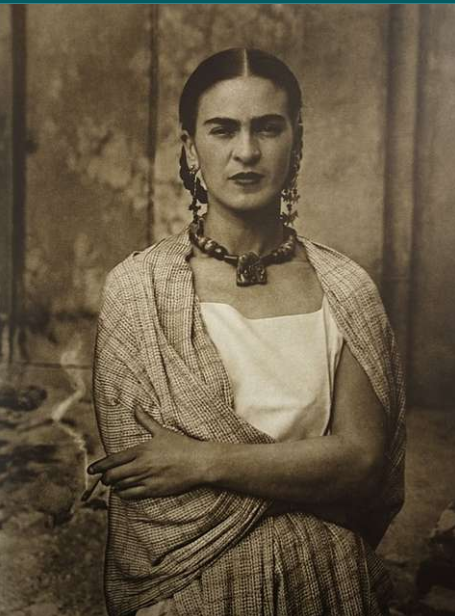Frida Kahlo and Her Legacy
November 17, 2022
Magdalena Carmen Frida Kahlo y Calderón, commonly known as Frida Kahlo, was a Mexican artist. Born July 6, 1907, in Coyoacán, Mexico City, Mexico, Kahlo was born the sixth to her parents Guillermo Kahlo and Matilde Calderón y González. Guillermo Kahlo was a photographer originally from Germany. There is no information about Calderón y González other than she was of European and Indigenous American descent.
As a child, Kahlo was disabled with polio, leaving her right leg and foot damaged. She was a promising pupil and had planned to attend medical school until an incident that happened when she was eighteen. During an accident with a trolley car and a bus going at full speed, a metal pole went through Kahlo’s midsection, leaving her with permanent spine issues, infertility, and other various injuries. No longer able to work as a medical illustrator, Kahlo took up her childhood hobby, painting, and had the idea of becoming an artist.
Kahlo’s first painting was a self-portrait in 1922. Of her 143 paintings, 55 are self-portraits. Kahlo painted the beautiful artifacts of Mexico and depictions of her own emotional and physical experiences.
After joining the Mexican Communist Party due to her interest in politics, Kahlo met Diego Rivera, a fellow artist. The couple married in 1929 and spent the next few years exploring Mexico and the United States, allowing Kahlo to find her artistic style. A painting by Kahlo, Frieda and Diego Rivera, painted two years after their wedding, is often interpreted as a wedding portrait. Kahlo and Rivera had a complicated relationship. They had messy fights, affairs, and even divorced for a year before remarrying. During their marriage, Rivera had a fling with Cristina Kahlo, Frida’s sister, which led to their year-long divorce. Throughout their marriage, both of them were unfaithful and had many affairs. Kahlo had both male and female lovers, and while Rivera encouraged her romances with women, he was often jealous of her male partners and was more delighted than offended when Kahlo flirted with women. Despite the unfaithfulness, fights, and bitterness, their love for each other was endless and Rivera was with Kahlo until her final days.
Kahlo’s first solo exhibit was in 1938 at the Julien Levy Gallery in New York. Her work was a success. Throughout the 40s, Kahlo participated in exhibitions in Mexico and taught art at La Esmeralda located in Mexico City. She also founded the Seminario de Cultura Mexicana in the same decade. Her already compromised health started to go downhill quickly and Kahlo died in 1957 at age of 47. The cause of death was diagnosed as a pulmonary embolism, but suicide was suspected because Kahlo became increasingly more depressed and dependent on other people as her health declined. Many of her paintings are sorrowful and depict her life with her disabilities. Her artwork didn’t become popular until the 70s, about 20 years after her death when historians and politicians rediscovered her art.
By the 90s, almost 40 years after her death, Kahlo was known as a staple in art history. She was an icon and inspiration for Chicanos, known for painting all the beautiful aspects and history of Mexico, and continuing to dress in traditional Indeginous clothes throughout her life. Kahlo became a symbol for Mexican culture and pride. She became a known face in the feminist movement, having often broken gender stereotypes by dressing like a man and letting her facial hair grow. Kahlo often painted herself with masculine or androgynous features, and painted about female issues that were often, and still are, considered taboo, such as abortion, miscarriages, birth, and breastfeeding. Despite being considered “masculine,” Kahlo didn’t hide her woman-ness and never held back in decorating herself with bright colors, flowers, ribbons, and long dresses. Kahlo also became an icon in the LGBTQ+ community having never hidden her bisexuality and openly painting about female sexuality.
Today, Frida Kahlo is still known as a symbol of pride throughout many communities: Mexican communities, feminists, the LGBTQ+ community, and people with disabilities. Even 60 years after her death, Kahlo is an inspiration around the world for so many people. Her paintings gave a look into one of the most interesting lives the world has ever seen.
































































































































